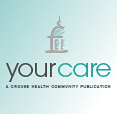Breast Imaging
For many women, having a mammogram and any additional diagnostic testing can create anxiety. Our team, comprising the area’s most experienced radiologists, mammography technologists and certified breast health navigators, is dedicated to providing you with prompt, accurate screenings, combined with individualized comfort, compassion and emotional support.
The Falk Breast Health Center at Crouse Hospital, the first area program to be designated a Breast Imaging Center of Excellence by the American College of Radiology, offers the latest in 3D mammography, digital mammography,image-guided biopsy, computer-aided detection of malignancy and breast MRI with computer-aided detection.
Because providers at the Falk Breast Health Center know that breast imaging of the highest caliber is vital to the early detection — and treatment — of breast cancer, they work with each individual patient to calm fears, while providing the best in imaging services.
Digital Imaging & Testing
Tomosynthesis or 3D Mammography
At Crouse, we use the most advanced 3D digital mammography, also called Tomosynthesis, which is the newest and most advanced technology in breast cancer detection. Our radiologists view 3D images to detect breast cancer, ideally as early as two years before a lump can be felt.
Patients with no symptoms receive a screening mammography procedure. Those with breast lumps or other concerns receive a diagnostic mammogram, which may include an ultrasound of the breast. Because images are processed digitally, they can be viewed, optimized and stored for easy access by your physician or hospital staff as needed.
Current guidelines from the U.S. Department of Health and Human Services (HHS), the American Cancer Society (ACS), the American Medical Association (AMA) and the American College of Radiology (ACR) recommend screening mammography every year for women, beginning at age 40.
Watch:Next Generation 3D Mammography Technology at Crouse Health
Breast Ultrasound
A breast ultrasound will be ordered if an area of concern is identified on the mammogram; if a lump is felt that cannot be seen on the mammogram; or if breast tissue is dense. Gel is applied to the area to be scanned and a transducer is passed gently over the skin. Sound waves are reflected off the internal structure of your breast to reconstruct an image on a computer. A breast ultrasound test usually takes between 15 and 30 minutes.
Breast Biopsy
The only way to definitively confirm if breast tissue is cancerous or benign (non-cancerous) is through a procedure called biopsy. A sample of tissue, cells or fluid is extracted
for evaluation in a laboratory. We may perform this by vacuum assisted core biopsy or fine needle aspiration. Please know that breast biopsies do not cause cancer to spread.
Magnetic Resonance Imaging (MRI)
An MRI of the breast is a painless procedure in which radio waves and powerful magnets are used to create detailed pictures of the breast without the use of radiation.


